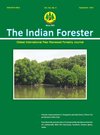Population Dynamics of Major Insect Pests on Ailanthus excelsa Roxb. And their Management in Arid and Semi-Arid Areas of Rajasthan and Gujarat
DOI:
https://doi.org/10.36808/if/2016/v142i9/56315Keywords:
Multipurpose Trees, Ailanthus excelsa, Insect Pests, Control Measures.Abstract
In the past few years, problems of land degradation and unavailability of intensive agricultural system to farmers have encouraged them to grow more multipurpose trees species such as Ailanthus excelsa. It is an important agro-forestry tree species. The demand for Ailanthus excelsa has increased for its valuable use as fodder, firewood, medicine, timber, toy making, packing and plywood, matchstick industries etc. It can be easily grown in adverse conditions of desert regions of Rajasthan and Gujarat being a salt tolerant species. An extensive surveywas made in Tonk area of Rajasthan and Mehsana of Gujarat. It was found that A. excelsa is affected by a number of insect pests infesting the whole lot of plantation and farmlands. A total of thirty-one species of insect and non-insect pests have been recorded to cause minor to severe levels of damage to the root, shoot, bark, leaf, seed, flower and fruits of A. excelsa plantations. Therefore, the present study aims at measuring the damage intensity caused by major pests and thereby finding control measures to bring their population to non-destructive minimal levels.References
Bhasin G.D. and Roonwal M.L. (1954). A list of insect pests of forest plants in India and the adjacent countries (arranged alphabetically according to plant genera and species for the use of Forest Officers). Part II. List of insect pests of Plant Genera (A). Indian Forest Bulletin. (New Ser.),17 (1):42-43.
Cantisano A. (2000). Aphid outbreaks: Why they happen and what to do about them. Growing for Market : 6–8.
Chatterjee P.N., Singh P. and Misra R.M. (1969). Studies on the ecology life history and parasite complex of Ailanthus defoliator Eligma narcissus Cramer (Lepidoptera: Noctuidae) together with morphology of adult and immature stages. Indian Forester, 95 (8): 541550.
Indiati S.W. (2014). The use of sugar apple and neem extract to control leaf eating pest on soybean. Journal of Experimental Biology and Agricultural Sciences, 2(2): 208-214.
Jat H.S., Singh R.K. and Mann J.S. (2011). Ardu (Ailanthus sp) in arid ecosystem: A compatible species for combating with drought and securing livelihood security of resource poor people. Indian J. Tradi. Knowledge, 10 (1): 102-113.
Khanna P. (2012). Agroforestry in Gujarat: an economic opportunity with environment enhancement, Social forestry, Gujarat state +12 pp.
Kumar D., Bhat Z.A., Singh P., Shah M.Y. and Bhujbal S.S. (2010). Ailanthus excelsa Roxb. is really a plant of heaven. Inter. J. Pharmacology, 6 (5): 535-550.
Mathur R.N., Chatterjee P.N. and Sen Sarma P.K. (1970). Biology, ecology and contril of Ailanthus defoliator Atteva fabriciella Swed. (Lepidoptera: Yponomeutidae) in Madhya Pradesh. Indian Forester, 97(6): 538-542.
Markova G. (1992). Beauveria bassiana (Bals.) Vuillemin, as a pathogen of ash weevil, Stereonychus fraxini Deg. (Coleoptera: Curculionidae) in Bulgaria. J. Applied Entomology, 114: 275-279.
Misra R.M. (1978). A Mermithid parasiteof Atteva fabriciella Swed. Indian Forester, 10 (2): 133-134.
Misra R.M. (2000). Insect pests of Ailanthus excelsa and their management. Bishen Singh Mahendra Pal Singh, Dehradun + 99 pp.
Nair K.S.S. (2007). Tropical forest insect pests- Ecology, impact and management. Cambridge University Press + 404 pp.
Orwa C., Mutua A., Kindt R., Jamnadass R. and Anthony S. (2009). Agroforestree database: a tree reference and selection guide version 4.0 (http://www.worldagroforestry.org/sites/treedbs/treedatabases.asp)
Pillai P.K.C., Sruthi M.R. and Mahendran R. (2014). Seed handling and nursery practices of teak, (Thulasidas, P.K., Chundamannil, M., Muralidharan, E. M. and Sandeep, S. eds.) 1-6: In: Teaknet Bulletin, 7 (1).
Sharma M. and Ahmed S.I. (2004). Orientation of Rohida defoliator, Patialus tecomella (Coleoptera: Curculionidae) to different light colors and varieties of Tecomella undulate (Sm.) Seem. Indian Forester, 130 (12):1416-1421.
Sharma M. and Sharma N. (2012). Atteva fabricella Swed. Aur Eligma narcissus indica : Adusa ko hani pahuchane vale keet tatha unka niyantran. In : Taruchintan, Media and Extension Division, Directorate of Extension, ICFRE, Dehradun, pp : 25-26.
Sharma Meeta and Sharma N. (2014). Ovi-larvicidal activity of Rockon, an extract of cinnamon oil against lepidopteron pests, 170p. : In: International conference: changing scenario of pest problems in agri-horti ecosystem and their management held on 27-29 November, 2014 at Udaipur.
Singh R.V. (1982). Fodder trees of India, Oxford and IBH Publishing Co.:1-663.
Varma R.V. (1986). Seasonal incidence and possible control of important insect pests in plantations of Ailanthus triphysa. K.F.R.I., Research Reports, Peechi, Kerala, 39: 1-42.
Wheeler P.A. and Ward R.B. (1998). The Non-Toxic Farming Handbook. Acres USA, Metairie, LA + 236 pp.
Zakariya S., Buhari S.Y. and Peni A.I. (2014). Effects of various doses of Neem-Afri biopesticide on the mortality and emergence of adult CallosobruchusMaculatus (Fabricius) [Coleoptera:Chrysomelidae] reared oncowpeaseeds.Entomology andScienceLetters,1,4:4-7.
Downloads
Downloads
Published
How to Cite
Issue
Section
License
Unless otherwise stated, copyright or similar rights in all materials presented on the site, including graphical images, are owned by Indian Forester.





